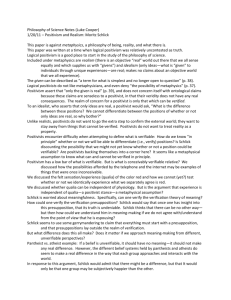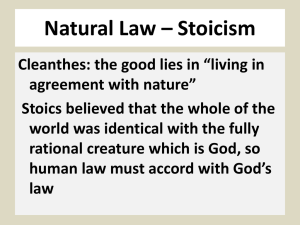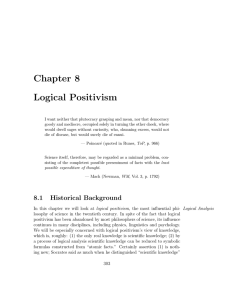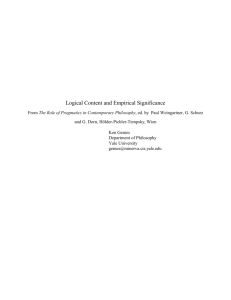Logical Positivism: Origins, Concepts, and Vienna Circle
advertisement
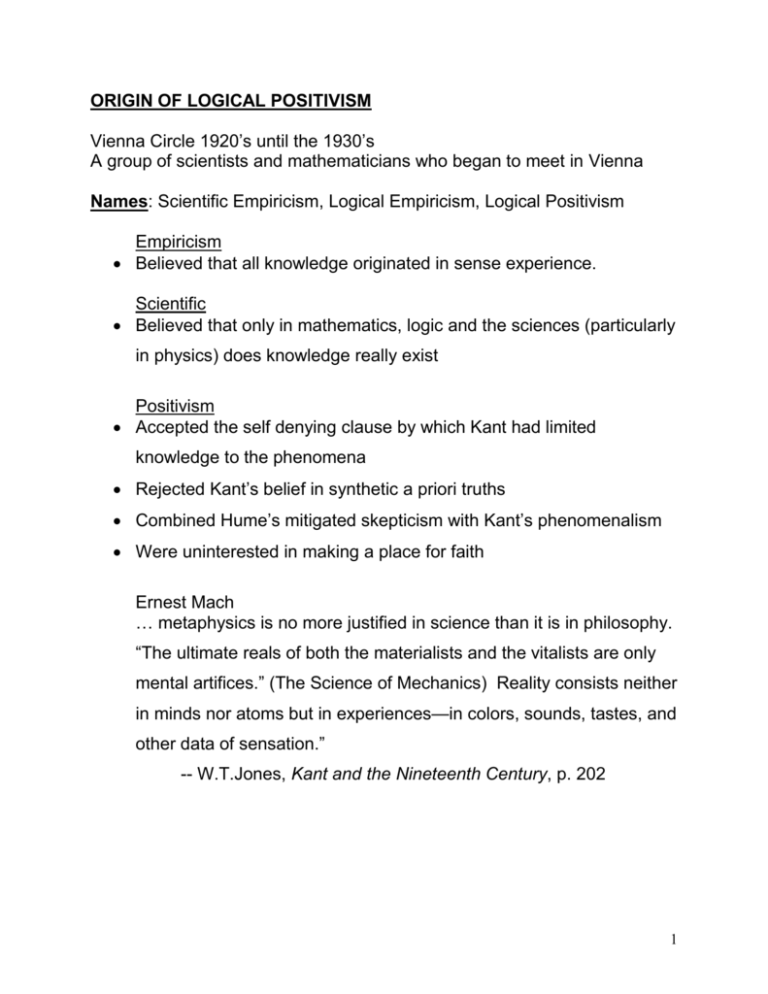
ORIGIN OF LOGICAL POSITIVISM Vienna Circle 1920’s until the 1930’s A group of scientists and mathematicians who began to meet in Vienna Names: Scientific Empiricism, Logical Empiricism, Logical Positivism Empiricism Believed that all knowledge originated in sense experience. Scientific Believed that only in mathematics, logic and the sciences (particularly in physics) does knowledge really exist Positivism Accepted the self denying clause by which Kant had limited knowledge to the phenomena Rejected Kant’s belief in synthetic a priori truths Combined Hume’s mitigated skepticism with Kant’s phenomenalism Were uninterested in making a place for faith Ernest Mach … metaphysics is no more justified in science than it is in philosophy. “The ultimate reals of both the materialists and the vitalists are only mental artifices.” (The Science of Mechanics) Reality consists neither in minds nor atoms but in experiences—in colors, sounds, tastes, and other data of sensation.” -- W.T.Jones, Kant and the Nineteenth Century, p. 202 1 EPISTEMOLOGY Empiricists but not skeptics, nor relativists, nor subjectivists. They wanted to put science on a secure footing and thought they could do so. Metaphysics: The Michelson Morley experiment, for the positivists, confirmed the fact that ether did not exist. They thought that the existence of metaphysical entities could be disproved in the same way. That is, they believed that all statements of philosophy (including metaphysics), should be confirmable through systematic observation. All meaningful statements are either analytic or synthetic (a distinction originating with Leibniz) Formulated the Verifiability criterion a way of bringing the methodology of the sciences to philosophy Schlick’s “Positivism and Realism presents the Verifiability Criterion and It is the peculiar business of philosophy to ascertain and make clear the meaning of statements and questions. The chaotic state in which philosophy has found itself during the greater part of its history is due to the unfortunate fact that, in the first place, it took certain formulations to be real questions before carefully ascertaining whether they really made any sense, and, in the second place, it believe that the answers to the questions could be found by the aid of special philosophical methods, different from those of the special sciences. But we cannot by philosophical analysis decide whether 2 anything is real, but only what it means to say that it is real; and whether this is then the case or not can be decided only by the usual methods of daily life and of science, that is, through experience . . . The content of our insight is indeed quite simple (and this is the reason it is so sensible). It says: a proposition has a statable meaning only if it makes a verifiable difference whether it is true or false. -- Moritz Schlick, “Positivism and Realism,” translated by D. Rynin, in Logical Positivism, ed. by A. J. Ayer (Free Press, New York, 1959), p. 86 POSITIVISM AND METAPHYSICS: Idealism and Realism This paper by Schlick also shows how, according to him, positivism differs from both realism and idealism. It is unlike idealism for it does not believe that the external world is ideal. But it is also unlike the realist position that there exists a world external to us. In opposition to both, it claims that statements about the existence of an external world are meaningless. The chief opposition to our view derives from the fact that the distinction between the falsity and the meaninglessness of a proposition is not observed. The proposition “Discourse concerning a metaphysical external world is meaningless” does not say: “There is no external world,” but something altogether different. The empiricist does not say to the metaphysician “what you say is false,” but “What you say asserts nothing at all!” He does not contradict him, but says “I don’t understand you.” 3 -- Moritz Schlick, “Positivism and Realism,” translated by D. Rynin, in Logical Positivism, ed. by A. J. Ayer (Free Press, New York, 1959), p. 86 THE POSITIVISTIC PROGRAM: LOGICAL CONSTRUCTION The positivists adopted Russell’s program of logical construction as well as his methodology of an expanded logic, with the dual goal of (1) eliminating nonsense and (2) securing sense. They found an outline of this program in Wittgenstein’s Tractatus, which they read carefully (1921), despite the fact that they could not get along with Wittgenstein personally. Analysis terminates in simples. When language has been correctly analyzed, its structure will mirror the structure of the world There has been much debate about the nature of Wittgensteinian simple facts and that of simple objects. Likewise the positivists struggled to define these concepts. However, they concluded from two premises above that the world consists in a set of atomic facts that the simple names that designate. And the next goal of the positivists became that of identifying atomic facts and the type of sentences that designate such facts. To fit with the positivist program and the principle of verification, the atomic facts must be empirically observable. That is, part of the positivist program was the task of starting from the propositions of the sciences and, through logical construction, tie them to what Ayer called observation sentences, sentences about directly experienced simples. 4 Accordingly, in order to find the meaning of a proposition, we must transform it by successive definitions until finally only such words occur in it as can no longer be defined, but whose meanings can only be directly pointed out. The question remained, what could be directly pointed out? One candidate was simple events, such as a person noticing a thing: “Mr. X saw blue on September 3, 1998.” However, many problems were noticed in such sentences. The problems of what is simple (blue objects, the color blue itself, etc.) The fact that such a sentence contains inferences and is thus a form of hypothesis (and is thus further reducible) The problems of building a person and their perspective In response to the difficulty of Neurath’s protocol sentences, Schlick introduced confirmation sentences, which were supposed to tie into simples more directly and thus be more certain than protocol sentences. For example, given a protocol sentence like the one above, the corresponding confirmation sentence would be the sentence uttered at that time, “Blue this here now.” Despite the improvements, confirmation sentences had their own problems: The apparently privacy and lack of objectivity of sense data. THE UNITY OF SCIENCE MOVEMENT: PHYSICALISM Although the positivists believed that each science should set off to ground their complex sentences upon, they further believed that there was one set 5 of simples in the world, with one foundational science into which all the other sciences could be reduced. They also agreed with Wittgenstein that the structure of language must mirror the structure of the world. As a result, there must be one language to which all other languages could be reduced. “The thesis of physicalism maintains that the physical language is a universal language of science – that is to say, that every language of any sub-domain of science can be equipollently translated into the physical language. From this it follows that science is a unitary system within which there are no fundamentally diverse objectdomains, and consequently no gulf, for example, between natural and psychological sciences. This is the thesis of unity of science. -- Rudolf Carnap, The Logical Syntax of Language, 1937, p. 320 As antimetaphysicians and verificationists, positivists could not maintain that one set of entities was ontologically superior to any other. However, sometimes the positivists (particularly Schlick) slipped into metaphysics in believing that the given simples were not just epistemologically more certain but also ontologically superior. 6
